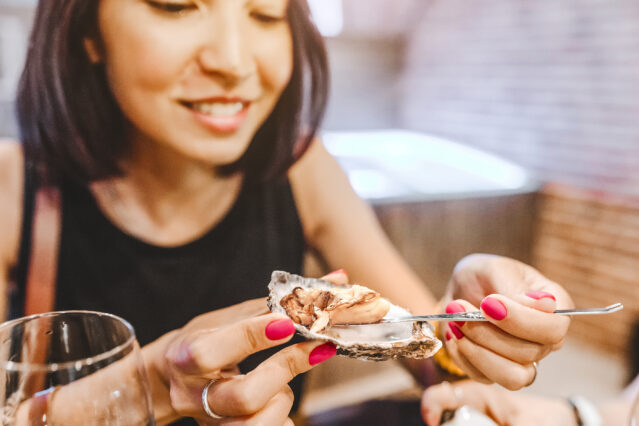---------------------------------------

We’re all supposed to eat a “healthy diet,” but what does that really mean? Off the bat, you probably think getting enough about protein and fatty acids (notably the vital omega-3s), plus important vitamins and minerals. But there’s also the less obvious: things like prebiotics and, the topic of today’s post, antioxidants.
Antioxidants, as I’ve discussed previously, defend the body from free radical damage. Free radicals are unstable molecules that knock around, pillaging electrons from other molecules and causing DNA damage and oxidative stress. When free radicals run amok, the damage they cause contributes to premature aging and chronic diseases.
Antioxidants’ job is to limit free radical formation and neutralize them when their numbers become too great. Plant and animal foods deliver important antioxidant vitamins, minerals, flavonoids, carotenoids, and other substances that the body can’t produce itself. To cover your antioxidant bases, since there’s no way to avoid free radicals, here are some antioxidant-rich foods to include in your diet.
How Do You Measure Antioxidant Levels in Foods?
Certain antioxidants are fairly easy to quantify. You can use any food tracking app to look up the amounts of antioxidant vitamins A, C, and E you consume in a day.
Others, like antioxidant enzymes, are considerably more complicated. Scientists have devised various methods of measuring the total antioxidant capacity of food. You have your crocin bleaching assay (CBA), trolox equivalent antioxidant capacity (TEAC), total oxyradical scavenging capacity assay (TOSC), ferric reducing antioxidant potential (FRAP), DPPH assay, and many more.19 (Don’t worry, there won’t be a quiz later.)
The most well-known antioxidant index is the ORAC score. ORAC, or oxygen radical absorbance capacity, was developed by scientists at the National Institute on Aging in 1992. Despite its popularity, the USDA renounced ORAC in 2012, on the grounds that ORAC doesn’t necessarily predict how much antioxidant activity happens in the body and to discourage supplement manufacturers from making strong claims about the power of their antioxidant formulations.
Nevertheless, researchers continue to use ORAC, and it remains the best way for the average person to look up which foods have relatively higher or lower antioxidant content. Don’t get too hung up the numbers, though. The question of whether these foods actually supercharge your body’s ability to fight free radicals is still up for debate. A lot of factors probably go into it, including how much of these compounds you absorb and the freshness of the food you consume.
As I see it, the best reason to consider antioxidant values is that you’ll probably end up revisiting some otherwise nutritious foods you might not be eating already. The foods that tend to score highly on antioxidant metrics are also ones that are widely considered healthy by other standards—colorful vegetables and fruits, organ meat, seafood.
Super Food List: High-Antioxidant Foods
Plant foods high in antioxidants
Plant foods tend to be higher in antioxidants than animal products, though the latter are still important for checking certain antioxidant boxes. “Eating the rainbow” will net you a good spectrum of vitamins, minerals, and other antioxidants. You can also intentionally add high-antioxidant foods in the mix.
Here are 12 plant-based foods and beverages that can boost your antioxidant intake (based on a combination of ORAC and FRAP scores):
- Berries
- Coffee
- Chocolate (the darker the better)
- Chia seeds
- Artichokes
- Plums and prunes
- Pistachios
- Pomegranate
- Figs
- Kalamata olives
- Kale
- Green tea
If you’re lucky enough to have dog rose berries or rowanberry in your area, definitely include those as well.
Animal foods high in antioxidants
On an absolute basis, the antioxidant capacity of these foods is lower than the plant foods above. However, these animal foods are among the best sources of the trace minerals copper, selenium, iron, manganese, and zinc, plus other antioxidants like lutein that are crucial pieces of the body’s antioxidant defense system.
- Liver
- Oysters
- Salmon
- Crab
- Lamb
- Beef
- Eggs
- Mussels
- Tuna
- Sardines
What say you? Do you think about antioxidants when putting together your meal plan, or is that not really a consideration for you? What are your favorite high-antioxidant foods?
The post High-Antioxidant Foods appeared first on Mark's Daily Apple.
-----------------------------------------
By: Mark Sisson
Title: High-Antioxidant Foods
Sourced From: www.marksdailyapple.com/high-antioxidant-foods/
Published Date: Fri, 14 Jul 2023 20:45:36 +0000
Read More
Did you miss our previous article...
https://prohealthsciences.com/general-health-and-wellness/thcb-gang-episode-130-thursday-july-13
 General Health and WellnessFitness and ExerciseSupplements and VitaminsPandemic NewsVideosPrivacy PolicyTerms And Conditions
General Health and WellnessFitness and ExerciseSupplements and VitaminsPandemic NewsVideosPrivacy PolicyTerms And Conditions
